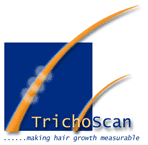
|
Measuring Hair Loss one Follicle at a
Time...
July 15, Marburg Germany
Until recently, it has been
nearly impossible to accurately measure the changes in a
persons hair loss over time. Whether you want to know if
things are getting worse, or slightly better, the methods
available today to give you an answer to these
inquiries are shoddy at best. Even the clinical studies
we all put so much faith in have very imperfect measurement
tools. For these scenarios especially, accuracy is of
the utmost importance.
|
Say you've been on Propecia for 6
months, and all you see is more hair in the shower every day.
You've convinced yourself that it's not working, and you've spent
endless hours being annoyed, depressed, and feeling hopeless.
Asking a dermatologist whether the treatment is working for you or
not would be an act in futility,
first and foremost because chances are, all he can do is look at
your head and comment. What he has to say probably won't be
very helpful because you know he's just guessing, and those of you
who are just starting to lose your hair may even risk being told
you're not losing it in the first place, which could
make you go postal right there in the waiting room.
In order to reduce violence in
Dermatologists offices all over the world, a new tool has been
created which takes the guesswork out of ... well .. guessing.
Your doctor, whom you may feel is clueless on most topics
(especially hair loss) will soon be able to speak with authority on
the issue thanks to a new invention known as
"TrichoScan".
Some Background
Thinning hair is a common "ailment"
for many of us, and a good percentage of us are not completely bald
just yet. With men, there is typically a well known pattern
for hair loss which can help a qualified person establish that you
are indeed losing your hair. The horseshoe shape pattern, the
bald spot in the back, etc. In the initial stages of
Androgenetic Alopecia however, you are usually the only person who
knows that changes are taking place. This typically is
why many of you have complained to us that your Dermatologist has
said: "You're not losing your
hair".
But you know you are...
As mentioned above, many times it is nearly
impossible to determine whether a treatment truly is working for
you. We've introduced the results of the Revivogen Consumer
trials this month in our July
Newsletter, but the very
basis for these results is assumption.
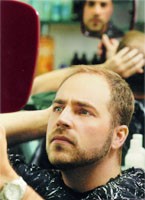 |
Even if these
participants were being closely monitored by physicians, the
comparison between baseline and current status for the hairs
that exist would be vague. Why? Quite simply, the
tools haven't existed to perform a perfect analysis.
Well what about the Propecia
studies, the Minoxidil studies, and all those hair counts,
percentages and seemingly exact data included with them?
Numerous methods are available to asses the *rate* of hair
growth. The techniques fall in to three
categories: Invasive (biopsies), semi-invasive
(Trichogram, unit area Trichogram), and non-invasive (global
hair counts, phototrichogram).
Some of these were used in the
Propecia trials. While they may be
somewhat accurate, researchers repeatedly find them time
consuming, costly, and sometimes very difficult to perform. |
TrichoScan - A New
Technology
In light of the cost, difficulty, and
inaccuracy of current methods, researchers in Marburg Germany saw a
need for a more "user friendly", patient friendly (no more
cutting your head open!), inexpensive, and accurate tool. The
results of their efforts produced the TrichoScan.
TrichoScan uses something called
Epiluminescence Microscopy (ELM), a fancy term for "digital
image",
along with automatic digital image analysis for measuring human
hair. Simply put, it takes a digital image of a section of
your head, and not only instantly counts the number of hairs there,
but also determines their length, width, and their current state
(Growth, Regression, etc.)...
The Boring Stuff
| In
order to understand how TrichoScan works, its important to
understand how hair works. The largest portion of the
hair follicle is really a fiber factory, consisting of
repeating cycles of the building and destruction of
keratinocytes. This building and destroying is manifest
in cyclic growth and regression phases.
Many of you who experience
shedding on a treatment are actually experiencing the cycling
of the hair phase from anagen (growth) into catagen
(regression) and sometimes telogen (resting). This
defined rhythm is controlled by numerous physiological and
pathological factors. No hair stays in growth phase
forever, however the Anagen phase typically lasts several
years, Catagen lasting a few weeks, and Telogen several
months. |
 |
Therefore, logically, you've got a
mass of hairs in Anagen (growth) phase, and only some individual hairs in
Catagen (regression) at any given time. On a typical human scalp,
approximately 18% of the follicles are in the Telogen (resting) phase at any
one time, while 40 - 50% are in telogen on your body. Those
with conditions such as Telogen Effluvium and Androgenetic Alopecia
(Male Pattern Baldness) have a much higher number of telogen hairs
on their head.
Knowing the exact ratio of anagen to
telogen follicles on a person's scalp is an effective way to
determine whether a person is losing their hair, and exactly how far
it has progressed. Likewise, being able to accurately detect a
decrease in telogen follicles when using a hair loss treatment can
reveal how successful that treatment truly is. Conventional
trichogram's can perform this function.
The Conventional
Trichogram
Today's most common method for
determining the anagen / telogen ratio on any given scalp is called
the Trichogram. It usually involves several painful epilations,
and several factors including the abstention from hair washing for
several days prior to the procedure, make it a difficult and
inconvenient test. The location and rate of the epilation may
vary, which can pretty much nullify the accuracy of the
results. Consequently, the conventional Trichogram is
beneficial only for basic evaluation of hair loss, not for exact
therapeutic monitoring.
Enter
TrichoScan...
TrichoScan can be viewed as a
modification of the classic Trichogram. The software that
comes with the procedure quickly and easily counts the number of
hairs and the anagen/telogen ratio within one operation. A
typical TrichoScan procedure will occur as follows:
Step 1: Shaving an area of
scalp that is approximately 1.8cm squared. Hair is not shaved
to the scalp, but only enough to leave short hair shafts
visible.
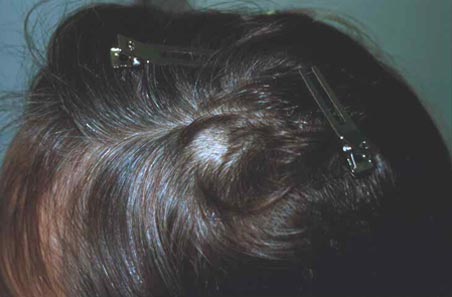
Step 2: 3 days is allowed to
pass. Die is then applied to the shaved area using a wooden
spatula. Die is left in place for 10 to 12 minutes.
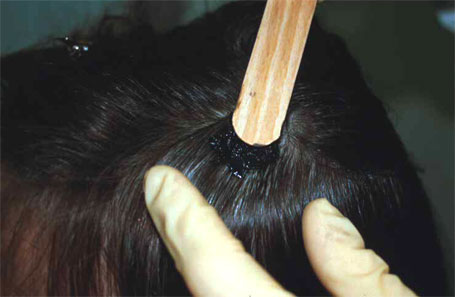
Step 3: A video Image is taken
at a magnification of 20 times.
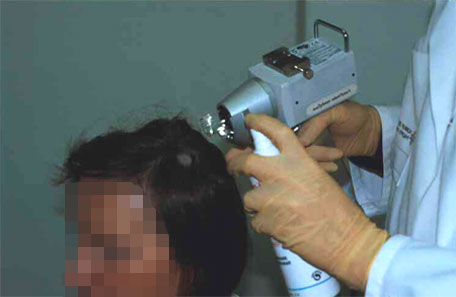
Step 4: Using the logic that
anagen hairs grow 0.3mm per day, and telogen hairs do not grow, the
TrichoScan software analyzes the image and determines the
anagen/telogen ratio.

In Conclusion
Before and after photos of a person
on any given treatment regimen allow a detailed conclusion to be
made regarding the success or failure of that hair loss
treatment. The advantages of the TrichoScan lie in its simple,
fast, and photographic processing, as well as the painlessness of
the procedure and the reproducibility of the results.
The dermatology clinic that has a significant proportion of clients with hair loss problems (mostly telogen effluvium and AGA) can use the approach as a simple, non-invasive method of measuring hair loss (and hair growth in response to treatment).
As long as the clinic has a suitable method for taking close up photos and scanning them into a computer, then they can use the software.
It's simple, cheap, effective, and doesn't require much expertise to apply. Much
simpler and cheaper than using traditional Trichogram, and more accurate and informative than global photographs.
The future of
TrichoScan
The creators of TrichoScan in Marburg
Germany are looking to market the tool to dermatology
clinics. You can help by printing this article and bringing it
to your dermatologist.
The second aim (and main aim) is to get the pharmaceutical companies interested in using the technique for screening in treatment trials. Some companies are very interested, but
they have a practical problem in that few companies are planning new trials right now.
It may take a while to get this end of the project off the ground.
No portion of this newsletter may
be used without the permission of HairlossSucks.com. You may
contact us at news@HairlossSucks.com
if you wish to reproduce an article on your site.
|
